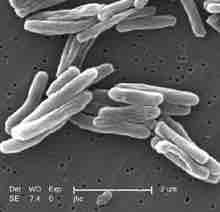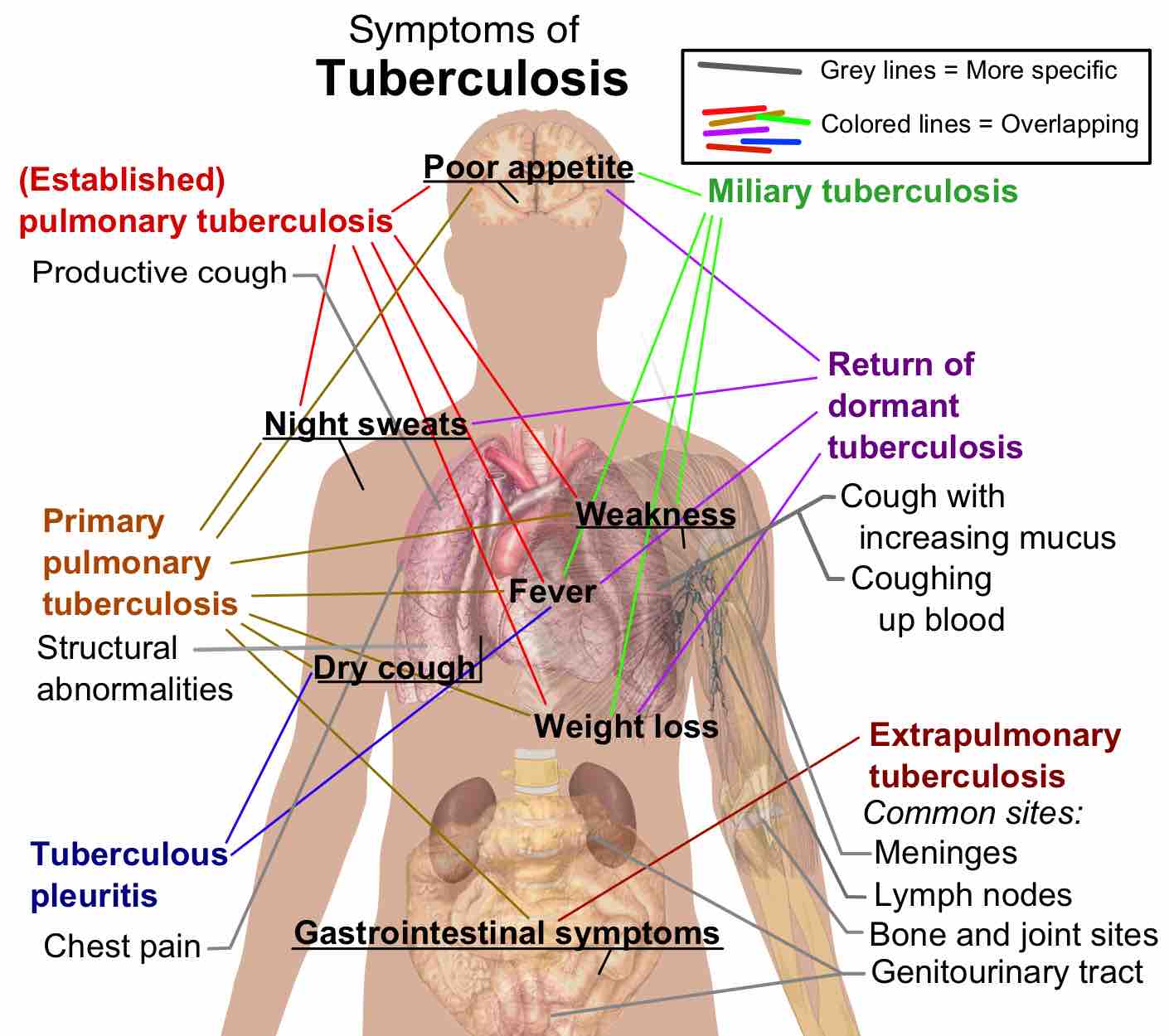Tuberculosis (TB; short for tubercle bacillus) is a common, and in many cases lethal, infectious disease caused by various strains of mycobacteria, usually Mycobacterium tuberculosis . Tuberculosis typically attacks the lungs, but can also affect other parts of the body. It is spread through the air when people who have an active TB infection cough, sneeze, or otherwise transmit their saliva through the air. Most infections are asymptomatic and latent, but about one in 10 latent infections eventually progresses to active disease which, if left untreated, kills more than 50% of those infected. One third of the world's population is thought to have been infected with M. tuberculosis with new infections occurring at a rate of about one per second.

Electron micrograph of Mycobacterium tuberculosis.
This bacteria is primarily responsible for TB.
Symptoms
The classic symptoms of active TB infection are a chronic cough with blood-tinged sputum, fever, chills night sweats, and weight loss . Tuberculosis may infect any part of the body, but most commonly occurs in the lungs, known as pulmonary tuberculosis. Extrapulmonary TB occurs when tuberculosis develops outside of the lungs, but may co-exist with pulmonary TB as well. Extrapulmonary TB occurs more commonly in immunosuppressed persons and young children. In those with HIV this occurs in more than 50% of cases. Notable extrapulmonary infection sites include the pleura (in tuberculous pleurisy), the central nervous system (in tuberculous meningitis), the lymphatic system (in scrofula of the neck), the genitourinary system (in urogenital tuberculosis), and the bones and joints (osseous tuberculosis). Tuberculosis may become a chronic illness and cause extensive scarring in the upper lobes of the lungs.

Tuberculosis Symptoms.
Diagram depicting various TB symptoms.
Diagnostics
Diagnosing active tuberculosis based merely on signs and symptoms is difficult, as is diagnosing the disease in those who are immunosuppressed. A diagnosis of TB should, however, be considered in those with signs of lung disease or constitutional symptoms lasting longer than two weeks. A chest x-ray and multiple sputum cultures for acid-fast bacilli are typically part of the initial evaluation. A definitive diagnosis of TB is made by identifying M. tuberculosis in a clinical sample such as sputum, pus, or a tissue biopsy. However, the difficult culture process for this slow-growing organism can take two to six weeks for blood or sputum culture.
The Mantoux tuberculin skin test is often used to screen people at high risk for TB. It involves injecting an protein extraction of the tuberculosis bacteria under the skin, and then examining the site 36-48 hours later. A person who has been exposed to the bacteria and has previously formed antibodies is expected to mount an immune response, displaying a raised, red area of skin at the site of injection. The test does have limited accuracy, especially in immunosuppressed people, and is typically used in combination with clinical findings and x-rays to reach a diagnosis.
Risk Factors
A number of factors make people more susceptible to TB infections. The most important risk factor globally is HIV; 13% of all TB cases are infected by the virus. This is a particular problem in sub-Saharan Africa, where rates of HIV are high. Tuberculosis is closely linked to both overcrowding and malnutrition, making it one of the principal diseases of poverty. Those at high risk thus include: people who inject illicit drugs, inhabitants and employees of locales where vulnerable people gather, such as prisons and homeless shelters; medically underprivileged and resource-poor communities; high-risk ethnic minorities, children in close contact with high-risk category patients, and health care providers serving these clients. Chronic lung disease is another significant risk factor. Those who smoke cigarettes have nearly twice the risk of TB than non-smokers. Other disease states can also increase the risk of developing tuberculosis, including alcoholism and diabetes mellitus. Certain medications that cause immunosuppression such as corticosteroids and infliximab, are becoming increasingly important risk factors, especially in the developed world.
Treatment
Treatment of TB uses antibiotics to kill the bacteria. Effective TB treatment is difficult, due to the unusual structure and chemical composition of the mycobacterial cell wall, which hinders the entry of drugs and makes many antibiotics ineffective. The two antibiotics commonly used are isoniazid and rifampicin. Treatments can be prolonged, from months to even years. A barrier to effective treatment is patient noncompliance. Due to the long duration of treatment, patients will often forget to take their antibiotics periodically or stop taking them altogether. This contributes to the development of drug-resistant tuberculosis. Many strains of tuberculosis have already become resistant to previous treatments, including a strain that is resistant to all antibiotics.
Latent TB treatment usually employs a single antibiotic, while active TB disease is best treated with combinations of several antibiotics to reduce the risk of the bacteria developing antibiotic resistance. People with latent infections are also treated to prevent them from progressing to active TB disease later in life.